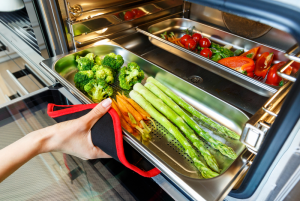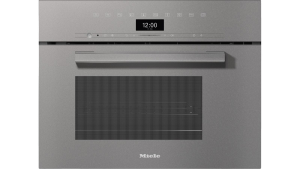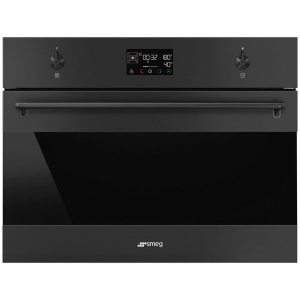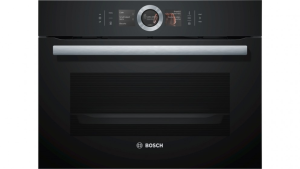If you’re sick of making the same old meals cooked the same old way, a steam oven could be the switch up in the kitchen you’re after. Steam ovens are a handy appliance that can help you eat healthier and make tastier meals by holding in nutrients better than traditional ovens. Read on to find out all you need to know about steam ovens with Canstar Blue.
What is a steam oven?
Steam ovens are ovens that use hot pressurised steam to cook food. While wall mounted steam ovens are more common in homes, you can purchase countertop microwave sized steam ovens too.
You can cook almost anything with a steam oven – you can even bake muffins and cakes! Steam ovens work particularly well for delicate foods, like scallops and croissants for example, but can also cook vegetables, fish and meats, and even add moisture back into leftovers – because no one likes dry leftover pizza or hot chips.
You may also be interested:
How does a steam oven work?
Traditional ovens work by heating air via a heating element, whereas steam ovens work by boiling water into steam, which then circulates around the food and heats it, which also retains moisture in the food. As water is a better heat conductor than air, steam ovens can cook your food faster than regular ovens.
There are two broad types of steam ovens: a standard steam oven and a convection steam oven. A standard steam oven solely uses steam to cook food, whereas a convection steam oven uses a fan to force air around the oven to cook the food quicker. Most steam ovens have a removable tank that can be refilled and cleaned, whereas others can be plumbed into a water line.

How much do steam ovens cost?
For a benchtop steam oven, you can expect to spend between $100 to $1,000, giving you plenty of price point options. A built-in steam oven will generally cost you a little more, sitting between $1,000 and $4,500 for low end steam ovens and between $1,500 and $13,000 for higher end built-in steam ovens. These prices will vary depending on brand and the features available for each steam oven.
What brands sell steam ovens?
If you’re looking to purchase a steam oven, there are a number of brands that sell a range of models including Miele, Smeg and Bosch. While steam ovens may not be considered an essential in every household, this appliance is becoming increasingly popular and being manufactured by more brands.
Miele steam oven

Miele have a broad range of steam ovens, predominantly combi steam ovens that offer both a standard fan forced oven function with added steam function. They have a broad price range with models costing between $4,000 and $13,000 with some boasting added microwave features, combination cooking and quantity independent cooking.
Smeg steam oven

Smeg is a well-known appliance brand in Australian kitchens, and offers a comprehensive range of steam ovens. Retailing between $2,000 and $6,000 there’s plenty to choose from in price and features. Some models include 18 individual functions and features including a cool touch door, pyrolytic cleaning for easy maintenance and microwave cooking to name a few.
Bosch steam oven

Bosch offers a small range of steam ovens retailing between $1,000 and $4,500. Most of their models are combi steam ovens, offering a steam function alongside the standard oven features giving you the best of both worlds. You can expect a sleek design with functions like a cooling fan, cleaning assistance and 3D Hotair fan for even cooking.
What are the pros of steam ovens?
There are multiple pros to owning and using a steam oven, including:
- Easy cleaning: Cooking with steam means the entire oven stays moist, making it harder for food to bake or burn onto the interior of the oven. It’s as simple as wiping out the inside – no furious scrubbing or harsh cleaning products necessary.
- Faster cooking: Steam ovens get your food onto your plate even faster than regular ovens, thanks to the greater heat-conducting capacity of steam.
- Healthier food: As steam cooking causes less damage to the vitamins and minerals in your food, you can get more nutrition out of your meals when cooked using steam.
- Tasty meals: Reheating food using a steam oven preserves and restores moisture, as opposed to using a microwave or standard oven which removes moisture. Steam cooking also preserves far more of the taste of fresh foods compared to methods like boiling, which can suck the flavour out, or dry roasting, which can change the flavour or take it away from many vegetables.
- Capacity: Using appliances like pressure cookers or rice steamers limits how much food you can steam at once. Buying a steam oven means that you can steam different foods at once without compromising on flavour.
What are the cons of steam ovens?
Steam ovens also come with a few disadvantages, such as:
- Browning and crisping: As steam ovens produce a moist heat, you can’t get that golden brown roast or crispy crust on food. If you don’t want to have two different types of ovens (one conventional and one steam oven) installed in your kitchen, a combination steam oven may be better. Combination steam ovens, or combi steam ovens, can be switched between dry heat and steam heat, so you can cook using steam then switch to dry heat to get a browned or crispy finish.
- Budget: Currently, steam ovens are more expensive than standard ovens. As they become more popular, prices are dropping, so they’ll likely become more affordable.
Are steam ovens worth it?
The average person probably wouldn’t get a whole lot of benefit out of a steam oven that couldn’t be achieved using other, cheaper steaming tools and appliances. However, if you like to steam your food regularly and in large volumes, getting a steam oven may be a great choice for you. So those gym junkies who do their weekly meal prep or busy families looking to stay healthy, this might be the appliance for you! If you’re interested in getting a new oven, be sure to check out our oven ratings to see which brands Australians rate!
Original Author: April Broadbent


Share this article